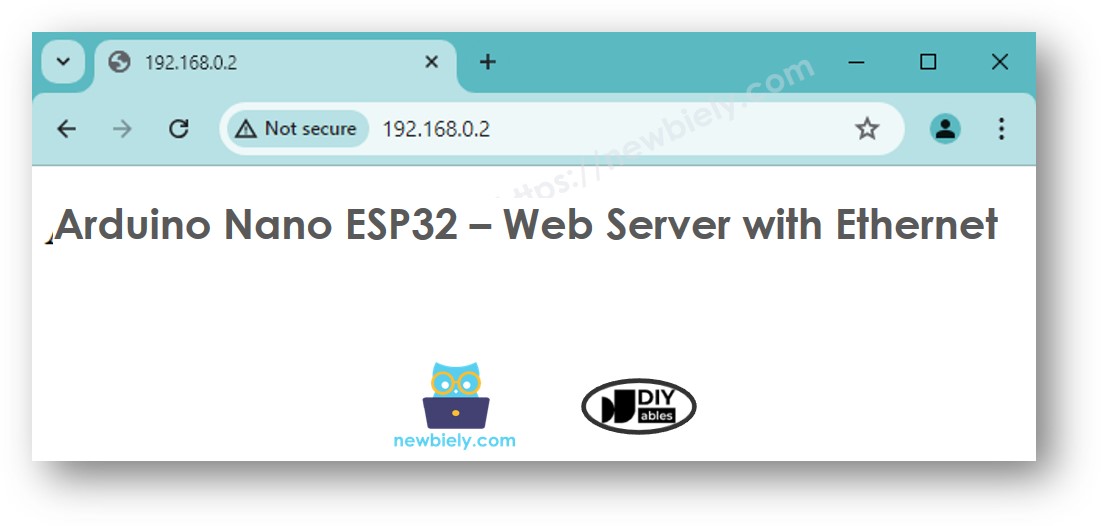Arduino Nano ESP32 - Ethernet
This guide shows you how to connect Arduino Nano ESP32 to the internet or your local network using the W55010 Ethernet module. You will learn the following:
- How to connect Arduino Nano ESP32 to W5500 Ethernet Module
- How to program Arduino Nano ESP32 for HTTP Requests through Ethernet
- How to create a simple Web Server on Arduino Nano ESP32 with Ethernet
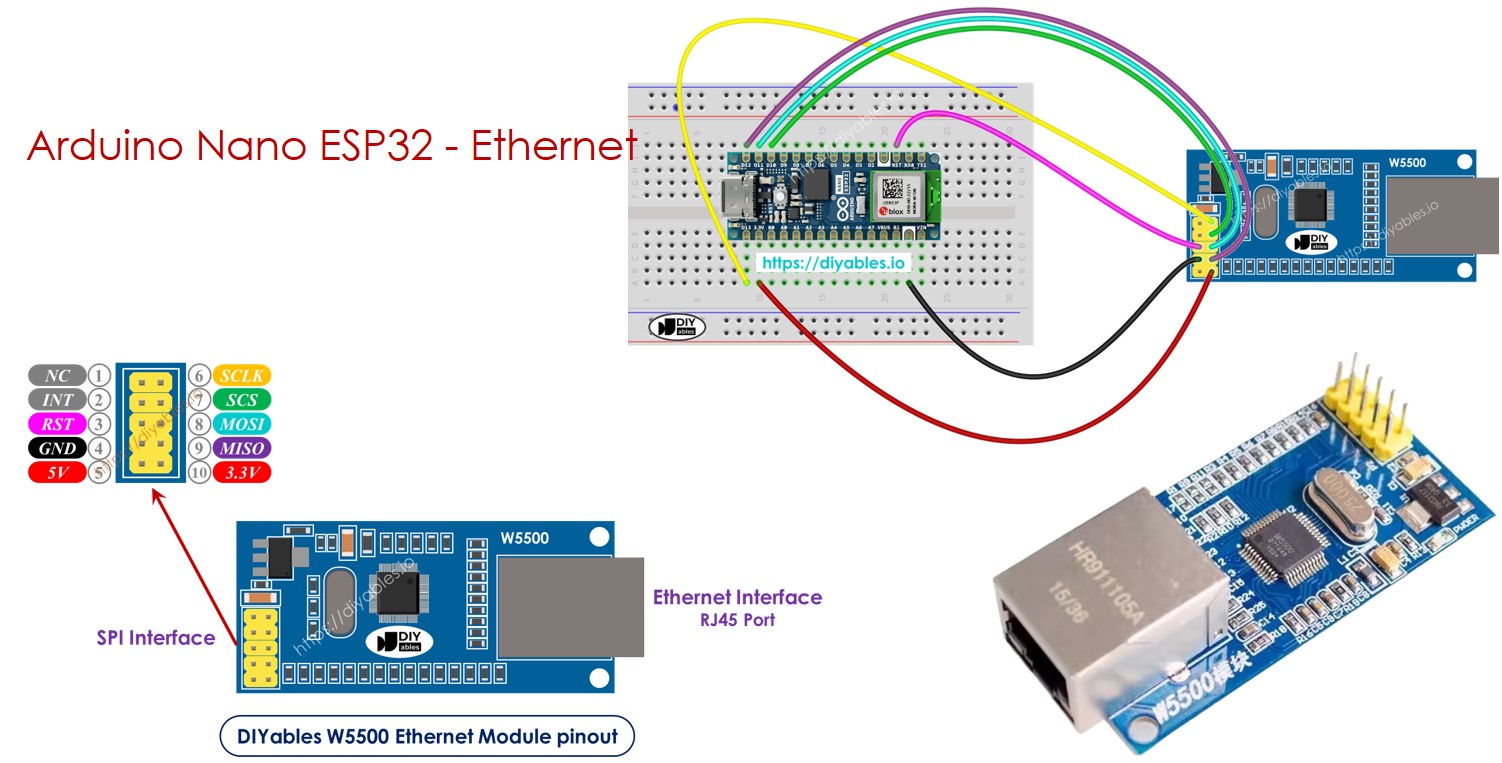
Hardware Preparation
Or you can buy the following kits:
| 1 | × | DIYables Sensor Kit (30 sensors/displays) | |
| 1 | × | DIYables Sensor Kit (18 sensors/displays) |
Disclosure: Some of the links provided in this section are Amazon affiliate links. We may receive a commission for any purchases made through these links at no additional cost to you.
Additionally, some of these links are for products from our own brand, DIYables .
Additionally, some of these links are for products from our own brand, DIYables .
Overview of W5500 Ethernet module
The W550io Ethernet module has two kinds of connections:
- RJ45 interface: Connect this to a router or switch using an Ethernet cable.
- SPI interface: Use this to link to an Arduino Nano ESP32 board. It includes 10 pins:
- NC pin: Leave this pin unconnected.
- INT pin: Leave this pin unconnected.
- RST pin: This is the reset pin; connect it to the Arduino Nano ESP32's EN pin.
- GND pin: Connect this to the Arduino Nano ESP32's GND pin.
- 5V pin: Do not connect this pin.
- 3.3V pin: Connect this to the Arduino Nano ESP32's 3.3V pin.
- MISO pin: Connect this to the Arduino Nano ESP32's SPI MISO pin.
- MOSI pin: Connect this to the Arduino Nano ESP32's SPI MOSI pin.
- SCS pin: Connect this to the Arduino Nano ESP32's SPI CS pin.
- SCLK pin: Connect this to the Arduino Nano ESP32's SPI SCK pin.
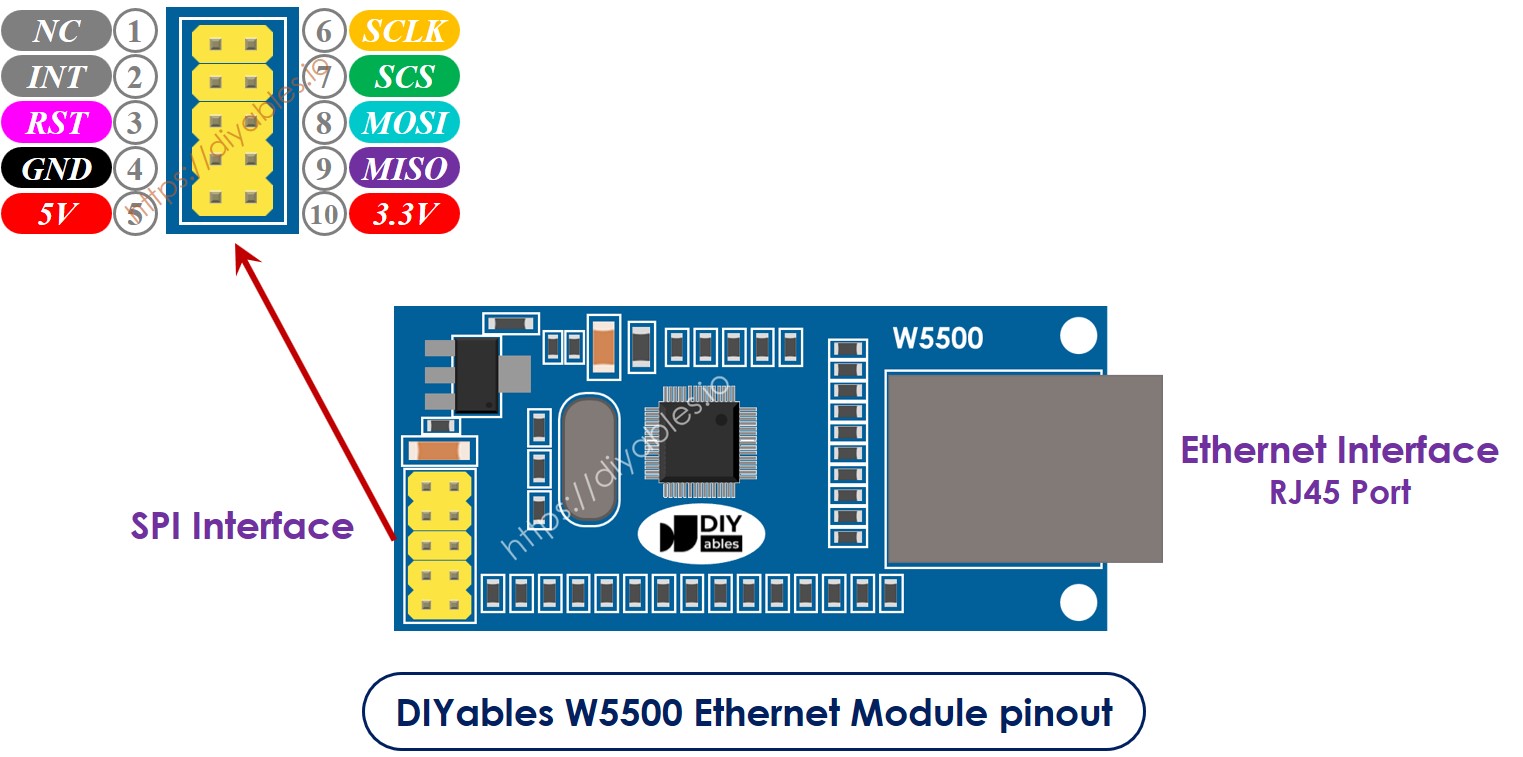
image source: diyables.io
Wiring Diagram between Arduino Nano ESP32 and W5500 Ethernet module
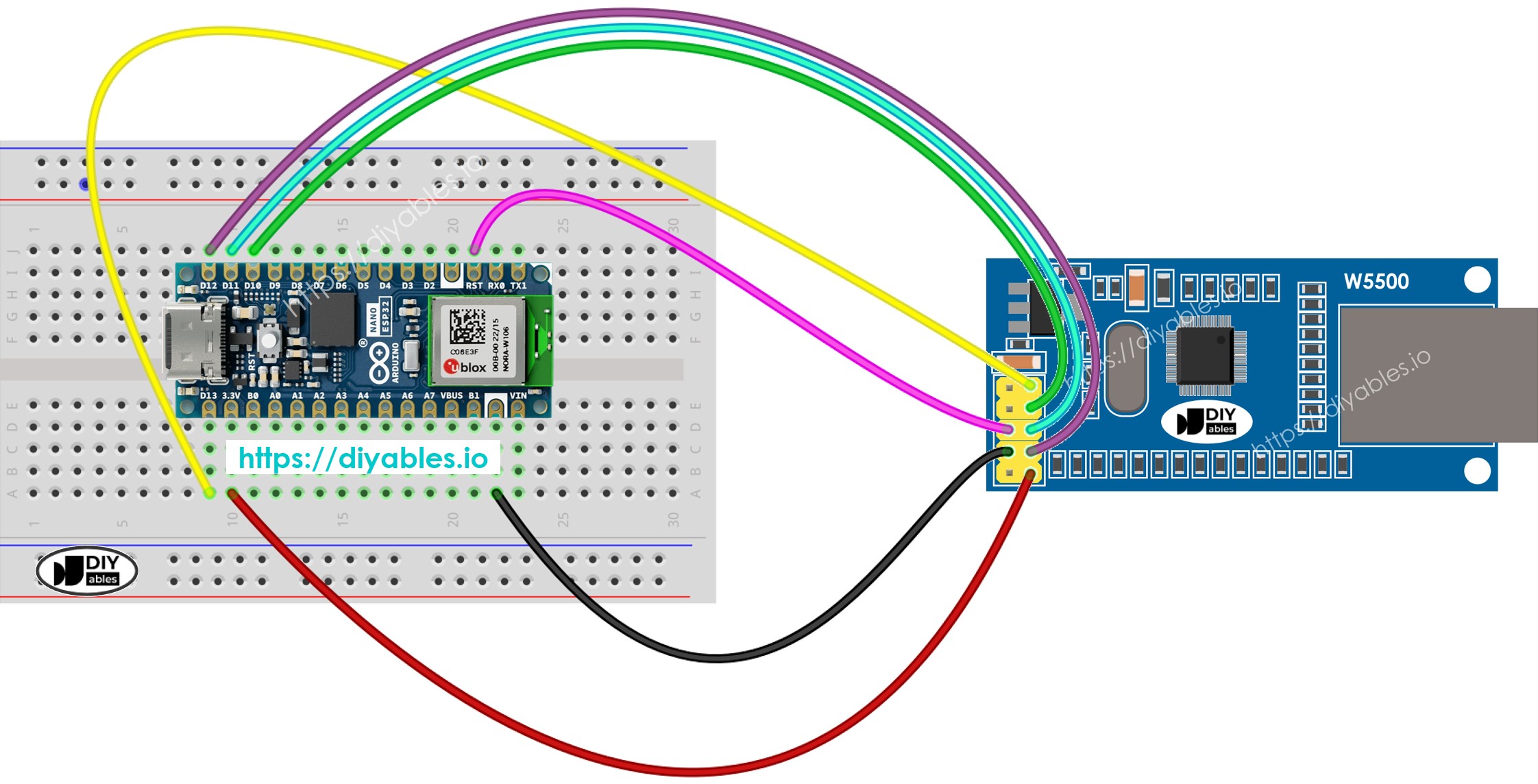
This image is created using Fritzing. Click to enlarge image
image source: diyables.io
Arduino Nano ESP32 code for Ethernet Module - Making HTTP request via Ethernet
This code functions like a web client. It sends HTTP requests to the web server at http://example.com/.
/*
* This Arduino Nano ESP32 code was developed by newbiely.com
*
* This Arduino Nano ESP32 code is made available for public use without any restriction
*
* For comprehensive instructions and wiring diagrams, please visit:
* https://newbiely.com/tutorials/arduino-nano-esp32/arduino-nano-esp32-ethernet
*/
#include <SPI.h>
#include <Ethernet.h>
// replace the MAC address below by the MAC address printed on a sticker on the Arduino Shield 2
byte mac[] = { 0xDE, 0xAD, 0xBE, 0xEF, 0xFE, 0xEF };
EthernetClient client;
int HTTP_PORT = 80;
String HTTP_METHOD = "GET"; // or POST
char HOST_NAME[] = "example.com";
String PATH_NAME = "/";
void setup() {
Serial.begin(9600);
delay(1000);
Serial.println("Arduino Nano ESP32 - Ethernet Tutorial");
// initialize the Ethernet shield using DHCP:
if (Ethernet.begin(mac) == 0) {
Serial.println("Failed to obtaining an IP address");
// check for Ethernet hardware present
if (Ethernet.hardwareStatus() == EthernetNoHardware)
Serial.println("Ethernet shield was not found");
// check for Ethernet cable
if (Ethernet.linkStatus() == LinkOFF)
Serial.println("Ethernet cable is not connected.");
while (true)
;
}
// connect to web server on port 80:
if (client.connect(HOST_NAME, HTTP_PORT)) {
// if connected:
Serial.println("Connected to server");
// make a HTTP request:
// send HTTP header
client.println(HTTP_METHOD + " " + PATH_NAME + " HTTP/1.1");
client.println("Host: " + String(HOST_NAME));
client.println("Connection: close");
client.println(); // end HTTP header
while (client.connected()) {
if (client.available()) {
// read an incoming byte from the server and print it to serial monitor:
char c = client.read();
Serial.print(c);
}
}
// the server's disconnected, stop the client:
client.stop();
Serial.println();
Serial.println("disconnected");
} else { // if not connected:
Serial.println("connection failed");
}
}
void loop() {
}
Detailed Instructions
To get started with Arduino Nano ESP32, follow these steps:
- If you are new to Arduino Nano ESP32, refer to the tutorial on how to set up the environment for Arduino Nano ESP32 in the Arduino IDE.
- Connect the Arduino Nano ESP32 to the Ethernet module according to the provided diagram.
- Connect the Ethernet module to your router or switch using a Ethernet cable.
- Connect the Arduino Nano ESP32 board to your computer using a USB cable.
- Launch the Arduino IDE on your computer.
- Select the Arduino Nano ESP32 board and its corresponding COM port.
- Click to the Libraries icon on the left bar of the Arduino IDE.
- Search “Ethernet”, then find the Ethernet library by Various
- Click Install button to install Ethernet library.
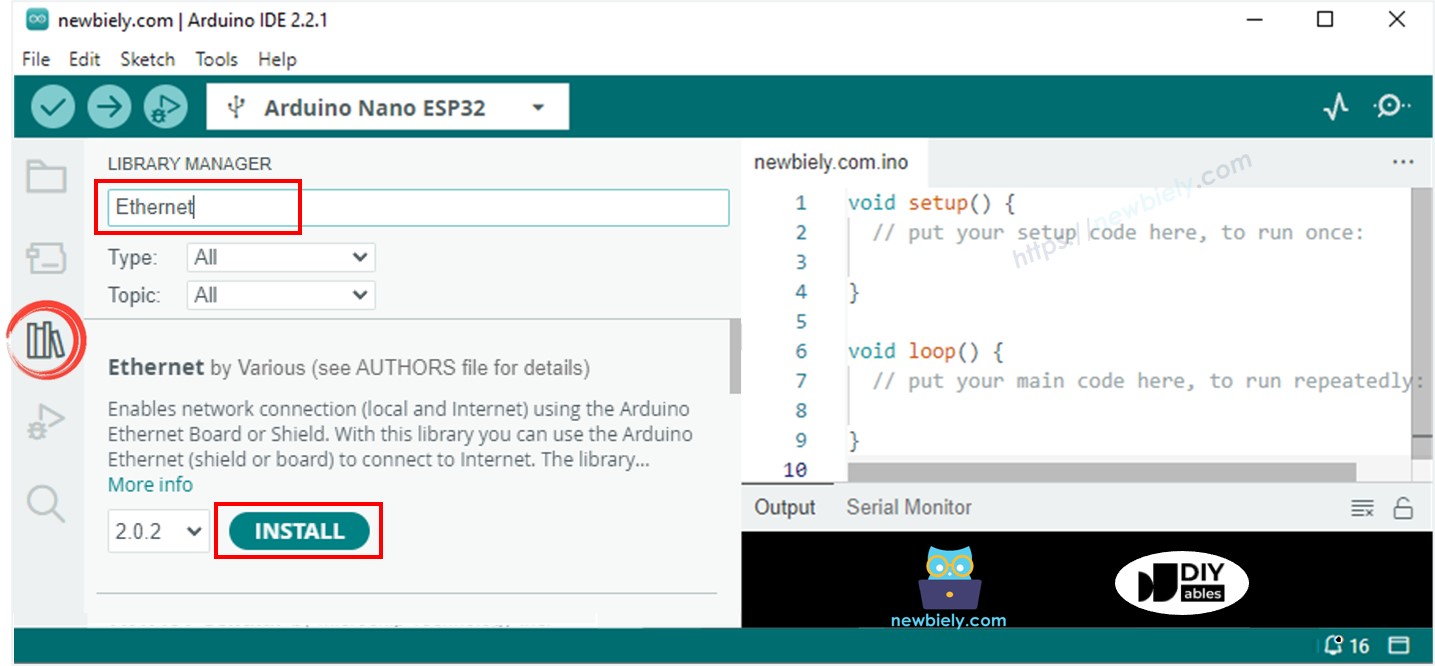
- Open the Serial Monitor in the Arduino IDE.
- Copy the code given and paste it into the Arduino IDE.
- Press the Upload button in the Arduino IDE to send the code to the ESP25.
- Check out the Serial Monitor which will display the output as below.
COM6
Arduino Nano ESP32 - Ethernet Tutorial
Connected to server
HTTP/1.1 200 OK
Accept-Ranges: bytes
Age: 208425
Cache-Control: max-age=604800
Content-Type: text/html; charset=UTF-8
Date: Fri, 12 Jul 2024 07:08:42 GMT
Etag: "3147526947"
Expires: Fri, 19 Jul 2024 07:08:42 GMT
Last-Modified: Thu, 17 Oct 2019 07:18:26 GMT
Server: ECAcc (lac/55B8)
Vary: Accept-Encoding
X-Cache: HIT
Content-Length: 1256
Connection: close
<!doctype html>
<html>
<head>
<title>Example Domain</title>
<meta charset="utf-8" />
<meta http-equiv="Content-type" content="text/html; charset=utf-8" />
<meta name="viewport" content="width=device-width, initial-scale=1" />
</head>
<body>
<div>
<h1>Example Domain</h1>
<p>This domain is for use in illustrative examples in documents. You may use this
domain in literature without prior coordination or asking for permission.</p>
<p><a href="https://www.iana.org/domains/example">More information...</a></p>
</div>
</body>
</html>
disconnected
Autoscroll
Clear output
9600 baud
Newline
※ NOTE THAT:
If another device on the same network has the same MAC address, it might cause problems.
Arduino Nano ESP32 code for Ethernet Module - Web Server
The code below turns the Arduino Nano ESP32 into a web server. This server sends a simple webpage to web browsers.
/*
* This Arduino Nano ESP32 code was developed by newbiely.com
*
* This Arduino Nano ESP32 code is made available for public use without any restriction
*
* For comprehensive instructions and wiring diagrams, please visit:
* https://newbiely.com/tutorials/arduino-nano-esp32/arduino-nano-esp32-ethernet
*/
#include <SPI.h>
#include <Ethernet.h>
// replace the MAC address below by the MAC address printed on a sticker on the Arduino Shield 2
byte mac[] = { 0xDE, 0xAD, 0xBE, 0xEF, 0xFE, 0xEF };
EthernetServer server(80);
void setup() {
Serial.begin(9600);
delay(1000);
Serial.println("Arduino Nano ESP32 - Ethernet Tutorial");
// initialize the Ethernet shield using DHCP:
if (Ethernet.begin(mac) == 0) {
Serial.println("Failed to obtaining an IP address");
// check for Ethernet hardware present
if (Ethernet.hardwareStatus() == EthernetNoHardware)
Serial.println("Ethernet shield was not found");
// check for Ethernet cable
if (Ethernet.linkStatus() == LinkOFF)
Serial.println("Ethernet cable is not connected.");
while (true)
;
}
server.begin();
Serial.print("Arduino Nano ESP32 - Web Server IP Address: ");
Serial.println(Ethernet.localIP());
}
void loop() {
// listen for incoming clients
EthernetClient client = server.available();
if (client) {
Serial.println("new client");
// an HTTP request ends with a blank line
bool currentLineIsBlank = true;
while (client.connected()) {
if (client.available()) {
char c = client.read();
Serial.write(c);
// if you've gotten to the end of the line (received a newline
// character) and the line is blank, the HTTP request has ended,
// so you can send a reply
if (c == '\n' && currentLineIsBlank) {
// send a standard HTTP response header
client.println("HTTP/1.1 200 OK");
client.println("Content-Type: text/html");
client.println("Connection: close"); // the connection will be closed after completion of the response
client.println();
client.println("<!DOCTYPE HTML>");
client.println("<html>");
client.println("<body>");
client.println("<h1>Arduino Nano ESP32 - Web Server with Ethernet</h1>");
client.println("</body>");
client.println("</html>");
break;
}
if (c == '\n') {
// you're starting a new line
currentLineIsBlank = true;
} else if (c != '\r') {
// you've gotten a character on the current line
currentLineIsBlank = false;
}
}
}
// give the web browser time to receive the data
delay(1);
// close the connection:
client.stop();
Serial.println("client disconnected");
}
}
Detailed Instructions
- Copy the code provided and paste it into the Arduino IDE.
- Click the Upload button in Arduino IDE to send the code to your Arduino Nano ESP32 board.
- Check the Serial Monitor to view the results as shown.
COM6
Arduino Nano ESP32 - Ethernet Tutorial
Arduino Nano ESP32 - Web Server IP Address: 192.168.0.2
Autoscroll
Clear output
9600 baud
Newline
- Enter the IP address provided into your web browser's address bar. You will see a simple webpage displayed by the Arduino Nano ESP32.
